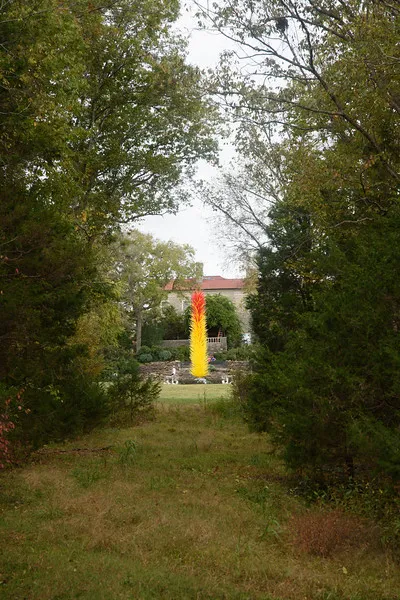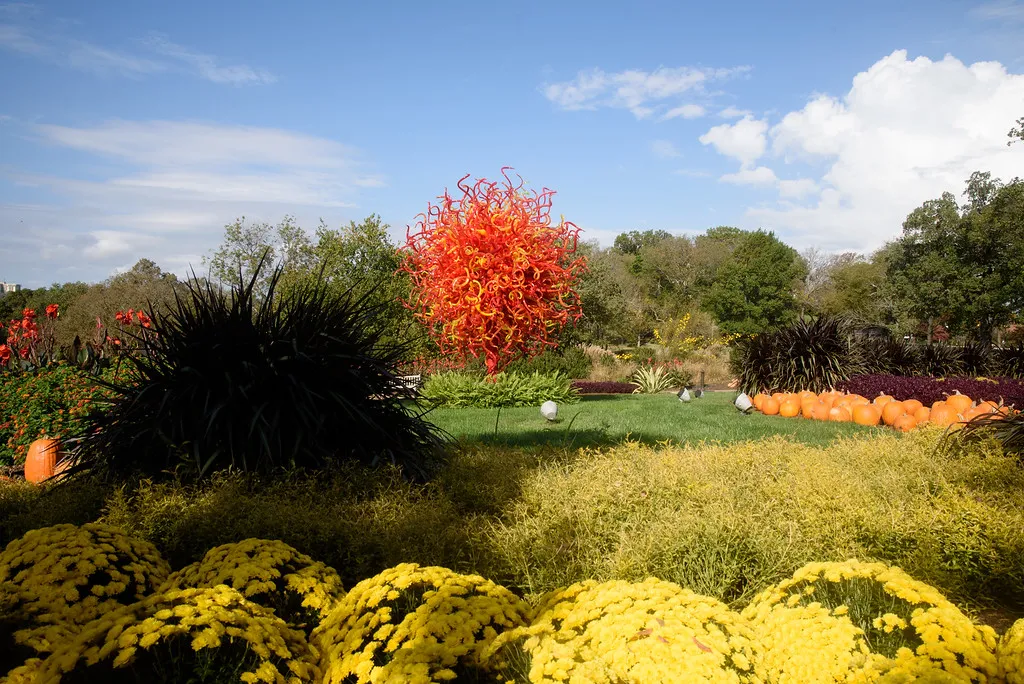I am so excited to share this post with you today. It is always great having guest bloggers sharing their knowledge, thoughts and ideas about art.
The last time we heard from Frankie was in December 2018. When she did a special piece on Henry Moore, an artist we both adore. Check it out- Art Talk: Guest Blogger, Frankie O'Neill
She is an art history major at Arizona State University (ASU) and she is going to share with us a technique on how to view art!

Dale Chihuly
Scarlet and Yellow Icicle Tower
Cheekwood Estate and Garden, Nashville, Tennessee
I am excited to look at this stunning piece through the lens of the Critical Response Process with Frankie as our both the teacher and the moderator.

Critical Response Process (Minus the Artist)
By: Frankie O’Neill
As an art history student ASU, examining art is the bread and butter of my coursework. Unlike my fellow art majors, constantly reviewing the art of their peers in studio classes, most of the art I review comes from dusty old books and created more than a hundred years ago. As much as I would love to chat with Degas about his dancers or discuss color over a slice of cake with Rembrant, I know that probably won’t happen. Despite this, the tools used by artists when critiquing the work of their peers can be very useful when trying to understand any piece of art--whether the artist can talk back to you or not.
In an provocative art history requirement course at ASU, “Encounters with Art,” I was recently exposed to a critique approach called the Critical Response Process. It was developed by Liz Lerman, a former dancer, to produce constructive dialogue between artists and art viewers. This system has clearly defined steps that guide you through the art observation process and will change the way you look at artwork forever.
Step 1: Statements of Meaning
This first step is all about talking about the work of art in without judging it. The viewer makes neutral statements about what stands out, what the piece reminds them of, specific details that may go unnoticed--anything without a judgement. Generally, in a live art critique, a moderator will ask the viewers a questions and stop anyone who wonders into the treacherous realm of passing judgement in their commentary.
What does this mean for someone standing in a museum or clicking through a digital exhibition? When you first look at a work of art, acknowledge your emotional reactions to it, but focus on observing the different elements first. Don't allow your immediate impulse to like or dislike a piece of art govern how you view it. Instead look closely at the details you would never normally notice, examine the colors, textures, composition--look at every aspect as if 10 people have already said things and it's your turn next! By doing this you end up “seeing” so much more of the piece than if you jump straight to judgement.
Sara is going to give this a try with Scarlet and Yellow Icicle Tower! We will walk through each step together and Sara will give us her commentary as we go.

Frankie (moderator):
Sara what stands out to you about this piece?
Sara:
First, is the color. The yellow is so bight!
Second, when I looked up I realize how tall it is (30 feet) and I felt so small next to it.
Third, it is spiky
Fourth, I can see yellows in the reds and reds in the yellows as I move up the piece.
Fifth, it reminds me of Big Stick popsicles that I used to eat when I was young that were yellow and red and shaped like this icicle tower.
Frankie (moderator):
There are always more things to notice. When you are doing this on your own you can spend as much time as you like in this section. Always look for different elements.
Step 2: Artist as the Questioner & Step 3: Neutral Questions from Viewers
Step 2 and 3 usually involve discussion between the artist and the viewers. Step 2 is where the artist may ask the audience specific questions about their work. Viewers are only allowed to respond to the artist’s question, they cannot provide general feedback at this stage. This step allows the artist to explore their work on their own terms and maximizes the value for them.
The tables turn in Step 3, when viewers can ask the artist their most burning questions--as long as they are phrased neutrally! They can ask “is there any meaning behind the use of red in this close up? Or is it just true to life?” for example, but can’t ask “what were you thinking when you put that red in there, it is crazy distracting!” The point in this step is to open up productive dialogue and illuminate the meaning behind artistic choices, not critique them.
Unless ghosts are now tuning in to your art viewing schedule, these steps are hard for the average museum goer to engage in. Rather, use this time to imagine what the artist might have asked. If something stands out, question if there is a specific meaning behind it. But engage in this imaginary conversation without judgement, ask questions as if there was a moderator standing right next to you! Let’s see how Sara does it!

Frankie (moderator):
Sara, if Chihuly was here what do you think he would ask you? What is he wanting to convey to us?
Sara:
How does the size affect you or How does the size make you feel?
Frankie (moderator):
Why do you think he is asking that? What would your response be if he did?
Sara:
I think he would ask because of all his pieces it is the tallest in the garden. He purposely made it that big and placed it where you can stand right next to it and far away and sense the scale both ways. There are life size lions right next to it for scale.
Frankie:
What would you ask him?
Sara:
I thought about this in the garden. I would for sure ask him where he thought people would be looking at it with the best point of view. Next to it, from the balcony of the mansion or across the lawn and through the trees.
 |  |  |
|---|
Frankie:
You can repeat this process over and over. There are always questions to be asked and answered. Even if the answers are your speculations.
Step 4: Permissioned Opinions
This step in the critical response process allows for viewers to express their opinions on different aspects of the work, with the permission of the artist. In a live critique, viewers must say “I have an opinion on (a specific element like color or composition). Would you like to hear it?” and then the artist can elect to hear or not hear that viewer’s opinion. Either choice is respected in the critique to maintain a safe and productive atmosphere.
For the regular viewer and art history students not graced by the presence of their selected artist, this step can take the form of articulating specific opinions about particular aspects of the piece. Now that you have observed and analyzed all the elements of the work, it’s time to make those final judgements. I guarantee they will be completely different from the judgements you would have made based on your first impressions. Let’s see what Sara has to say!
Frankie (moderator):
Sara, what is an opinion of a specific element or aspect of this work?
Sara:
I have an opinion about this piece in context to another piece in the garden.
The first piece I saw coming into the garden was Summer Sun which is also red and yellow glass. How I felt standing next to the icicle tower is one of a sun with the bright yellow, rays, and immense scale. My opinion is that the icicle tower is very much like a sun.
Frankie (moderator):
Thank you Sara!
Sara:
Thank you Frankie for asking these questions and helping me think about this work of art on a deeper level.


Even when not talking to a live artist, critical response theory forces you to experience a work of art more completely than just looking at it would ever allow you to. Next time you visit an art gallery or look at your favorite piece of art, try taking a step back, making neutral observations and carefully distilling your opinions. Not only will it make you sound really smart, but it’s super fun!
For more information about the Critical Response Process visit https://lizlerman.com/critical-response-process-resources/ or check out Liz Lerman’s book, Critical Response Process: A Method for Getting Useful Feedback on Anything You Make, from Dance to Dessert.
Hopefully this changes your perspective on art as much as it has mine! Good luck and happy viewing!

It is so great to have guest bloggers I learn so much!
This was such a great process to learn and walk through with Frankie. It helped me look at this piece in more detail and it was so fun and exciting to see more things about it. I will use this process when I am looking at other pieces of art in the future.

Art Talk Series Highlights
2020
Art Talk: Recycled Plastic Art Movement
Art Talk: Gates of Paradise
Art Talk: Sunrise as abstract art
March- Italian Renaissance
Art Talk: NGA Italian Renaissance Tour
Art Talk: Raphael
Art Talk: Venus
Art Talk: Egg Tempera
Art Talk: Guest Blogger, @laurabellamy
April- French Impressionism
Art Talk: NGA French Impressionism Tour
Art Talk: Fredric Bazille
Art Talk: The Mother and Sister of the Artist
Art Talk: En plein air
May- Hudson River School
Art Talk: NGA Hudson River School Tour
Art Talk: Albert Bierstadt
Art Talk: The Voyage of Life
Art Talk: Romanticism & Nature & Hudson River School
June-Andrew Mellon and the Hermitage
Art Talk: NGA Andrew Mellon and the Hermitage Tour
Art Talk: Rembrandt
Art Talk: The Annunciation
Art Talk: Provenance
July-Portraiture
Art Talk: NGA Portrait Tour
Art Talk: Rembrandt Peale
Art Talk: Portrait of My Grandmother
October- NGA Highlights
Art Talk: NGA Highlights tour
Art Talk: Artist highlight
Art Talk: Ginevra de’ Benci
November- Chihuly
Art Talk: Chihuly at Cheekwood Estate and Garden
2018
Art Talk: Introduction
Art Talk: Emotion in Bronze
Art Talk: Moore Across America
Art Talk: Bronze
Art Talk: Moore in America
Art Talk: King and Queen
Art Talk: Art Tells Our Story
Art Talk: Highlight Tour of the MET
Art Talk: The Burghers of Calais
Art Talk: Auguste Rodin
Art Talk: Art in Paris in the 1870s
Art Talk: Guest Blogger, Frankie O'Neill
Art Talk: "Felt is a happy fabric."
Art Talk: Murals in Klamath Falls
Art Talk: Woman with a Parasol- Madame Monet and Her Son
Art Talk: Respect and Compassion
2019
Art Talk: Art Connects Us
Art Talk: My mother's crystal
Art Talk: Mother and Child
Art Talk: Tour of the Galleria dell' Accademia
Art Talk: Walking tour of Florence, Italy
Art Talk: Chihuly at the Oklahoma City Museum of Art
Art Talk: Vatican tour highlights
Art Talk: Ceilings in the Vatican
Art Talk: Chihuly at Kew Gardens
Art Talk: MET Highlight tour
Art Talk: Japan at the MET
Art Talk: Up Close with French art at the National Gallery of Art in DC
Art Talk: Kelpies
Art Talk: Buying from local artists
Art Talk: Guest Blogger, Joia Doiron
Haveyoubeenhere 2019 Steemitworldmap travel contest- Four Wonderful Museums